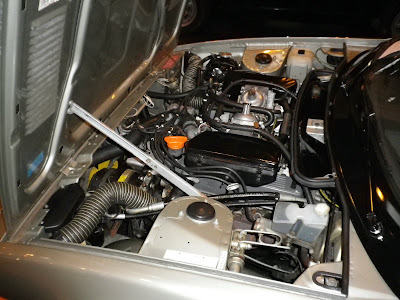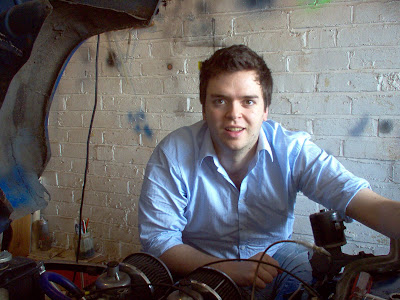I'm still slowly getting through the bodywork on the front half of the car. The bonnet top panel only needs to be separated from the drivers side bonnet cone panel and a minor repair made to the flange before it's good to go. The passenger side headlight support panel (a Steelcraft panel) is clamped in place and looks to be quite a good fit around the headlight area but looks like it might need a bit of a trim where it meets the wing. The bonnet strengthener is clamped in place too and I'm now working on fitting up the drivers side support panel. Next step for me is getting a new bonnet strengthening bar and start trial fitting the wheelarch panels. I did buy one off eBay but it turned out to be a bit bent so I had to scrap it!
This weekend I turned my attention to the drivers side rear wing. It seemed solid enough but when I passed over it with a 'Dronco' clean and strip disc I was in for a nasty surprise!
 Yeah, that's a seam weld running across the bottom half of the panel! The welding isn't bad but there is some horrible distortion in the panel and there was a lot of filler used to cover it! Next on my list of unpleasant was discoveries was this...
Yeah, that's a seam weld running across the bottom half of the panel! The welding isn't bad but there is some horrible distortion in the panel and there was a lot of filler used to cover it! Next on my list of unpleasant was discoveries was this... It's a fairly minor wheelarch dent. It's not too bad but it's an annoyance none the less! Finally, and I've saved the best for last, I found this...
It's a fairly minor wheelarch dent. It's not too bad but it's an annoyance none the less! Finally, and I've saved the best for last, I found this... I did cut into that a bit with some tinsnips to neaten it up so I didn't cut myself on it, but most of the metal was removed with my bare hands! A large chunk of boot floor, inner and outer wing literally came off in my hands!
I did cut into that a bit with some tinsnips to neaten it up so I didn't cut myself on it, but most of the metal was removed with my bare hands! A large chunk of boot floor, inner and outer wing literally came off in my hands!Finding the wing in such poor condition has really made my mind up to replace it. There doesn't seem much point in repairing the back of it when the front's already been done and there's a dent in the middle. You may as well do the whole thing while you can! It needs to come off anyway because I need to do the B pillar too as it's rusted through on the drivers side. I've already got a repair section for the back half of the inner wing so hopefully with that in and a new inner wheelarch (it has multiple patches) I should be back in business!
I made another annoying discovery this weekend too. When pulling off the weatherseal around the door aperture I realised that the flange where the outer sill meets the strengthener and the floorpan looked a bit odd. My worst fears were confirmed when I managed to slip a knife blade between the outer sill and the strengthener and move it about a foot without hitting a weld. I really need to look into this closer - the sills are supposed to have been replaced before I bought the car and I was hoping not to have to do too much work on them. I'm just glad I didn't have an accident in it - a large part of the cars strength is in those sills.
Finally, here's a few pictures of my boot. The boot floor looks like it may just be repairable but the rear valance needs full on replacement. Lot's of welding fun to be had in the future!




















































